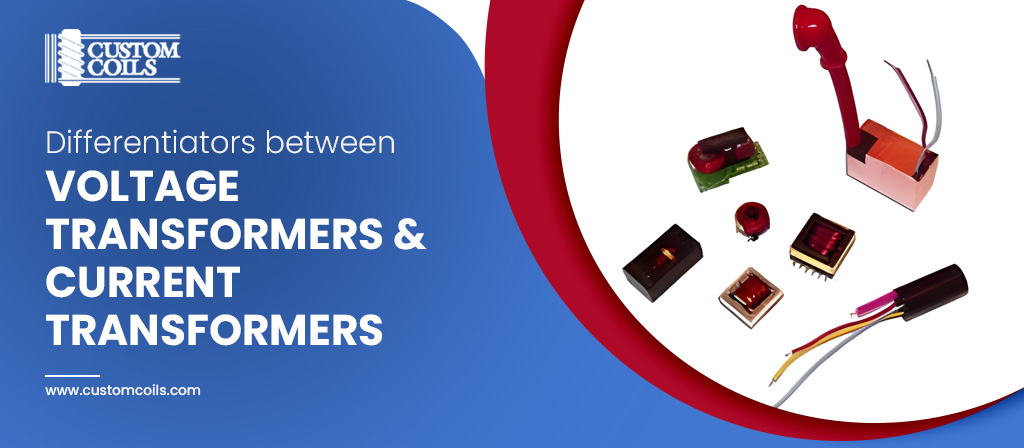Transformers help manage and control electricity in power transmission systems. High-voltage transformers are crucial components in power systems, ensuring the safe and efficient transfer of electrical energy. There are two main types of transformers that serve distinct functions: voltage transformers (VT) and current transformers (CT). This post highlights the key differences between these essential devices, highlighting their functions and characteristics.

An Overview of Current and Voltage Transformers
Current and voltage transformers differ in terms of their design and application. The following pointers will help you gain an initial understanding of these devices.
- Current Transformers (CT): A current transformer monitors high electrical currents safely and accurately in power grids. They work by stepping down the current in the power circuit to a manageable level. Due to their primary function, these devices are categorized as instrument transformers, which scale large current values to small and standardized values for easy measurement. These transformers are widely used in electrical substations, generating stations, and commercial and industrial electric power distribution systems.
- Voltage Transformers (VT): A voltage transformer, also known as a potential transformer (PT), is primarily designed to reduce high voltage values to lower, standardized secondary voltages, typically around 100V or lower. This reduction in voltage makes it safe and practical for use with measuring instruments and protection systems. These transformers effectively isolate high voltage from electrical systems, ensuring the safety of technicians and equipment.
Key Differentiators between Voltage Transformers and Current Transformers
Following are the key differentiators between the two transformers, encompassing their type, connectivity, material, winding and more,
-
- Types:
VTs: There are primarily three types of VT – electromagnetic, optical, and capacitive voltage transformers. The capacitive transformers use a capacitive potential divider, the electromagnetic transformer uses a wire wound transformer, and the optical transformer relies on Faraday effect for operation. The choice of the right VT would depend on your application requirements.
CTs: CTs are categorized into bar type, window type, and wound type transformers, offering flexibility to meet specific current measurement needs. Wound-type transformers comprise two separate windings on the magnetic steel core and are widely used for sensing the currents in the range of 1A to 100A. Window-type CTs do not feature the primary conductor and are quite affordable than the bar type of transformer. These transformers feature a primary conductor and are insulated to the switchgear voltage. The choice between these types depends on the application’s characteristics and requirements.
-
- Connectivity:
CTs: Current transformers are connected in series with the current to be measured. This means that the entire current flowing through the circuit passes through the primary winding of the CT.
VTs: Voltage transformers are connected in parallel with the circuit, allowing the full-line voltage to appear on the windings. This parallel connection facilitates accurate voltage measurement and isolation.
-
- Transformer Ratio:
CTs: CTs typically have a higher transformer ratio, which means they can effectively reduce high currents to much smaller secondary currents. This is essential for ensuring the safety and precision of current measurements.
VTs: Voltage transformers have a low transformer ratio as they primarily reduce high voltage values to a standardized secondary voltage. The transformer ratio depends on the specific voltage reduction requirements.
-
- Primary and Secondary Windings:
CTs: In current transformers, the primary winding has fewer turns carrying the current to be measured. The secondary winding has more turns and is connected to measuring instruments, providing the scaled-down output current.
VTs: Voltage transformers have primary windings with many turns that carry the voltage to be measured. The secondary winding, in contrast, has fewer turns and connects to instruments or meters, providing the scaled-down voltage output.
-
- Core Material:
CTs: Current transformers typically use silicon steel laminated cores to handle high currents and provide accurate measurements efficiently.
VTs: Voltage transformers use high-quality steel with low magnetic flux density to reduce voltage without introducing distortions or losses.
-
- Secondary Side:
CTs: The secondary side of a CT should not be open during use, as it could result in inaccurate measurements or damage to the transformer.
VTs: VTs allow the secondary side to be safely disconnected without causing damage. This feature enhances their flexibility and ease of use.
-
- Input Value:
CTs: Current transformers operate with a constant current input. They transform the input current to a lower value suitable for measurement and protection purposes.
VTs: Voltage transformers operate with a constant voltage input, ensuring the output voltage is consistent and compatible with measuring instruments.
-
- Burden:
CTs: CTs are not dependent on the secondary load for their operation. They provide precise measurements regardless of the load connected to the secondary winding.
VTs: The secondary load can affect the performance of voltage transformers, making it essential to consider the impact of the load when using VTs.
In conclusion, voltage and current transformers serve distinct functions in electrical systems, each tailored to specific measurement and safety requirements. Understanding these differences is important for selecting the suitable transformer for your application, whether it involves voltage reduction or current measurement. If you are considering high-voltage transformers for your application, partner with manufacturers like Custom Coils. They have a rich history of providing reliable and customizable solutions to various industry needs, ensuring quality, precision, and safety in electrical systems. Feel free to contact us to learn more about the high-voltage transformers offered by us.

